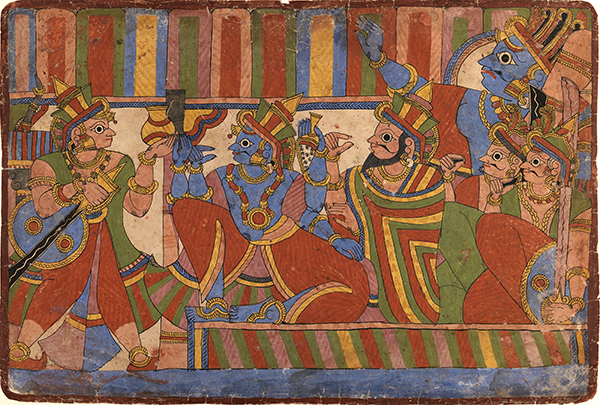July Gem of the Month: Chitrakathi
July is World Watercolor Month. Watercolor is a medium I’ve always admired (as you know from my drooling over Winslow Homer’s and John Singer Sargent’s gorgeous watercolor works), but have never mastered. I usually wind up trying to do in watercolor what I do in oils now. I thought a good work to feature as a kick-off is a new favorite genre of mine, the Chitrakathi storytelling boards from the Thakar community in Maharashtra, a state in India. Using a palette limited to primary and complementary colors, these watercolors are stunning and expressive, and in a distinctive style that often reminds me of ancient Mayan or Mixtec painting.
 |
| Thakar people, India, Krishna Counsels the Pandava Leaders, leaf from a bundle of individual scenes from the Mahabharata (Great Epic of India), ca. 1830–1850. Opaque watercolor on handmade paper, leaf: 11" x 16 ¼" (27.9 x 41.3 cm). © 2020 Brooklyn Museum. (BMA-2470) |
These visual-aid paintings are illustrations for Chitrakathi tales, often consisting of simplified drawings and shapes with large figures. They do not include text because they were presented with stories that were relayed orally and through music. Starting in the 1800s, the stories were illustrated in bright, mostly primary and complementary, colors. The earlier Chitrakathi illustrations were painted primarily in a range of values of brown pigment.
Typical stylistic features are the overemphasized frontally drawn eye, combination of frontal and profile poses, compressed space with no allusion to depth, and an overall decorative composition. The influence for these stylized, naïve figures is thought to be the puppets used by other forms of itinerant storytellers to illustrate their tales.
Painting has flourished in India since as early as 200 BCE in the form of fresco decoration. The Mughal period (1526–1750s) ushered in Persian and European influences in painting, as well as interest in everyday life of Indian people, noble and untouchable alike. In the 1400s, the introduction of papermaking from China and the development of vernacular (using a local dialect or language) literature encouraged the flourishing of illustrated stories and books. The desire for works in local dialects—rather than Sanskrit, which only the upper classes understood—led to the development of numerous regional schools of painting.
The once nomadic Thakar community of Chitrakathi storyteller artists are thought to have originated in Rajasthan but migrated to Maharashtra during the 1600s. Chitra means “picture” and katha means “story.” These storytellers presented tales from epic poems, religious texts, and mythological stories accompanied by pictures drawn on twenty or more leaves kept in bundles known as pothi, a sort of story board.
The Chitrakathi storytellers usually presented their picture stories in temples on holy days or at village festivals. Although considered the same as the untouchable caste, the storytellers were able to enter temples and take monetary offerings during performances. This storytelling tradition, which was in danger of dying out, is in the process of being revived by the Maharashtra state.
The Mahabharata is one of two Sanskrit epic poems about the struggles for kingship among two groups of cousins, the Kauravas and the Pandavas. The tale is a combination of historical and mythological material. It is considered a valuable record of the period during the development of Hinduism between 400 BCE and 200 CE. The book in its present form is thought to have been compiled around 400 CE.
Correlations to Davis Programs: Experience Painting: Chapter 4


Comments